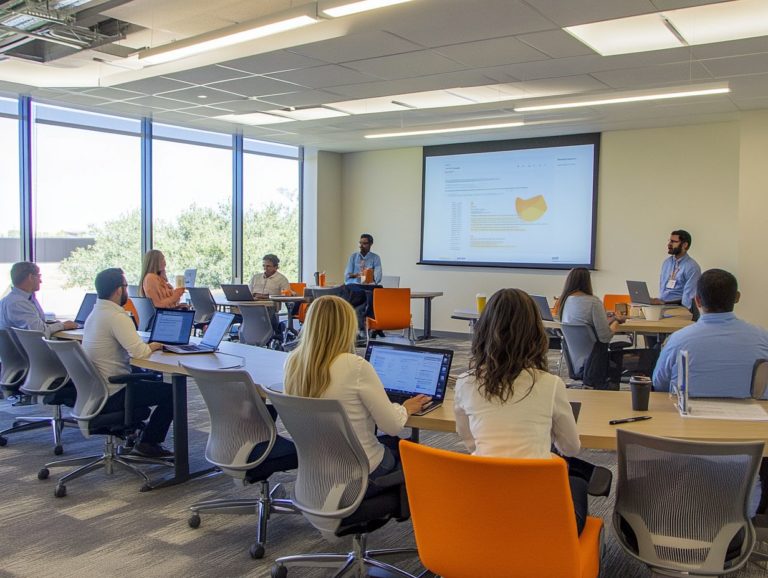How to Involve Current Employees in Onboarding
Effective onboarding holds immense value not just for new employees but for the company as a whole. Engaging current employees in this process cultivates a sense of community, significantly enhancing productivity and retention.
This article delves into the myriad benefits of involving employees during onboarding. It presents practical strategies such as mentorship programs, team-building activities, and shadowing opportunities.
It also addresses essential communication tactics and offers insights on measuring the success of onboarding initiatives. This ensures that continuous improvement and development remain at the forefront.
Contents
- Key Takeaways:
- The Importance of Employee Involvement in Onboarding
- Ways to Involve Current Employees in Onboarding
- Effective Communication Strategies
- Measuring Success and Making Improvements
- Frequently Asked Questions
- What is the importance of involving current employees in the onboarding process?
- How can current employees be involved in the onboarding process?
- What are some benefits of involving current employees in onboarding?
- What steps can be taken to involve current employees in onboarding?
- How can involving current employees in onboarding improve retention rates?
- What are some tips for successfully involving current employees in the onboarding process?
Key Takeaways:

- Get current employees involved in onboarding for mutual benefits, such as improved employee satisfaction and productivity, as well as increased company loyalty and retention.
- Use various methods, including mentorship, team building, shadowing, and informational interviews, to engage employees in the onboarding process.
- Effective communication is key. Clearly communicate expectations, actively listen, provide feedback, and measure success through feedback surveys and ongoing training.
The Importance of Employee Involvement in Onboarding
Your involvement in the onboarding process is vital not just for new hires but for the organization as a whole. It fosters a sense of belonging and facilitates a smoother integration into the workplace, especially when you consider how to make onboarding fun and interactive.
By actively engaging team members in this crucial experience, you can enhance the company culture, embody its values, and ultimately boost employee retention over time.
An effective onboarding approach that incorporates insights from current employees creates a valuable feedback loop. This allows HR teams to improve their methods continually, especially by exploring how to leverage social media in onboarding, aligning them with company goals and overcoming any onboarding challenges that may arise.
Your participation can truly make a difference in shaping a supportive and productive environment.
Benefits for the Employee and the Company
The advantages of a well-structured employee onboarding process are manifold. They benefit both you as a new hire and the organization as a whole.
It leads to an enhanced employee experience and a more cohesive company culture. When you are welcomed into the workplace through thoughtfully crafted onboarding activities, you ll find your wellness and integration improve.
This significantly alleviates any anxiety and shortens your acclimation period (the time it takes to adjust to your new role). This supportive atmosphere creates an exciting sense of belonging that empowers you right from day one!
As a result, organizations experience increased employee retention, as you and your colleagues feel valued and understood, which translates to greater job satisfaction.
Improved team dynamics arise when you engage in collaborative onboarding exercises, promoting camaraderie and instilling a shared understanding of company values that ultimately drives collective success.
Ways to Involve Current Employees in Onboarding
Engaging current employees in the onboarding journey of new hires can manifest in various ways. This includes implementing mentorship programs or orchestrating team-building activities designed to encourage social interaction and seamless integration, as well as using gamification in employee onboarding.
Mentorship Programs
Mentorship programs are essential to your onboarding experience. They provide you with a dedicated buddy who guides and supports you as you settle into your new role.
This structured approach not only makes your transition smoother but also cultivates a sense of belonging within the organization.
Through regular check-ins and personalized advice, your mentor will help you navigate the company culture, establish key relationships, and develop essential skills.
These initiatives enhance your support system, allowing you to seek advice and ask questions in a safe environment. This ultimately promotes faster integration and reduces early turnover.
As a result, these mentorship connections can lead to greater job satisfaction, improved productivity, and long-term loyalty to the company.
Get involved today to make onboarding a success!
Team Building Activities

Team building activities play a crucial role in shaping a welcoming environment that fosters social interaction, enhances team dynamics, and increases employee engagement during the onboarding process.
These activities whether they re icebreakers, team lunches, outdoor challenges, or collaborative problem-solving games serve a dual purpose. They not only help new employees get to know their colleagues but also cultivate a sense of belonging and friendship and teamwork that is essential for a cohesive workplace.
By incorporating such events early on, you send a clear message about your organization s commitment to a positive culture, which directly impacts retention rates and job satisfaction.
By encouraging participation in these varied activities, you lay the groundwork for trust and communication, significantly boosting overall productivity and morale.
Shadowing Opportunities
Shadowing opportunities provide you with a unique chance to observe your colleagues in action, offering valuable information into their job responsibilities and helping you gain a deeper appreciation for the organizational culture.
This hands-on learning method accelerates your acquisition of essential skills while fostering a sense of belonging and connection within the team.
By witnessing the dynamics of your coworkers and understanding the workflows in play, you ll become more adept at navigating your own responsibilities.
Shadowing also creates a welcoming platform for open communication, allowing you to ask questions and engage in discussions that enhance your retention of information and build your confidence.
Ultimately, this immersive experience facilitates a smoother integration into the workplace, giving you the power to transition seamlessly into your role while reinforcing the shared values and practices that define the organization.
Informational Interviews
Engaging in informational interviews with current employees can greatly enhance your onboarding experience, offering you a wealth of perspectives on company policies, job expectations, and avenues for employee development.
These conversations not only draw you into meaningful dialogue but also enable seasoned employees to share valuable information, fostering a rich culture of sharing valuable information and advice.
As you connect with your peers during these interviews, you gain clarity on your role and have the opportunity to build relationships that can lead to collaboration and support in the future.
These conversations also create a valuable feedback loop, allowing current employees to refine their understanding of the onboarding process based on your impressions. This ultimately paves the way for a smoother transition into the organization for future hires.
Effective Communication Strategies
Great communication strategies can make your onboarding experience truly successful! By prioritizing clear and concise dialogue, you can ensure that new hires fully grasp their job responsibilities, company policies, and the training plan designed for their development.
Clear Expectations and Responsibilities
Establishing clear expectations and outlining job responsibilities is crucial for you as a new hire to navigate your onboarding objectives and seamlessly integrate into the organization.
When you prioritize clarity in communication, it enhances your understanding of the framework within which you are expected to operate. This foundational knowledge fosters your confidence, allowing you to engage more fully with your role.
Defining specific responsibilities eliminates ambiguity, which is vital in minimizing the potential for miscommunication. As a result, you will feel empowered to ask questions, seek assistance, and make informed decisions.
This openness not only enriches your learning experience but also nurtures a collaborative atmosphere throughout the onboarding process, ultimately paving the way for your long-term success and job satisfaction.
Active Listening and Feedback

Active listening practices and a strong system for collecting feedback are essential for onboarding success. They create an atmosphere of open dialogue that significantly enhances employee engagement throughout the experience.
By genuinely tuning in to the concerns and questions of new hires, you cultivate an environment where employees feel valued and heard. By listening closely, you help ease worries and boost confidence, encouraging newcomers to engage actively in discussions about their roles and responsibilities.
Implementing an effective feedback system allows you to gather valuable insights from recent experiences. This is crucial for refining your onboarding strategies over time. These adjustments better align with the needs of incoming team members and foster a dynamic onboarding environment that evolves based on continuous input. This leads to better retention and satisfaction rates.
Measuring Success and Making Improvements
Measuring the success of onboarding initiatives is crucial for identifying areas that need improvement. This process helps organizations tackle onboarding challenges head-on, enhancing employee development and fostering a more effective joining experience.
Feedback Surveys
Feedback surveys serve as a powerful tool to gauge the onboarding experience. They offer invaluable insights that can shape your organizational culture and contribute to long-term onboarding success.
By systematically collecting input from new hires, you can identify areas for improvement, ensuring that essential aspects of the onboarding process align with the needs and expectations of your employees. To create effective surveys, write clear and straightforward questions that encourage honest feedback, focusing on key elements such as orientation, training effectiveness, and overall satisfaction.
As you analyze the results, you ll identify trends and concerns, fostering an environment of continuous improvement. Leveraging the data from these surveys enhances the employee experience, supports retention, and cultivates a positive organizational culture that values growth and communication.
Continuous Training & Development
Continuous training and development opportunities are essential for enhancing your onboarding experience. They ensure new hires feel well-prepared to meet their job responsibilities and contribute meaningfully to the organization.
By seamlessly integrating these opportunities into the onboarding process, companies can establish a supportive framework that motivates new hires from day one. This approach not only equips them with essential skills but also highlights the organization’s commitment to their growth.
Utilizing various onboarding resources like interactive training modules, mentorship programs, and regular feedback sessions fosters an environment that truly values ongoing learning.
In doing so, organizations cultivate a culture that encourages new hires to seek continuous improvement, adapt to industry changes, and ultimately drive innovation within the workplace.
Frequently Asked Questions
What is the importance of involving current employees in the onboarding process?

Involving current employees in onboarding helps create a welcoming and inclusive environment for new hires. It also promotes a sense of teamwork and collaboration, highlighting the role of employee engagement in onboarding among existing employees and new hires.
How can current employees be involved in the onboarding process?
Current employees can be involved in the onboarding process by participating in orientation sessions, providing mentorship and guidance to new hires, and including them in team activities and projects, which aligns with the role of HR in successful employee onboarding.
What are some benefits of involving current employees in onboarding?
Involving current employees in onboarding can lead to faster integration of new hires, improved communication and team dynamics, and a stronger sense of company culture and values. Learning how to use mentorship in employee onboarding can enhance this process even further.
Act now to refine your approach and watch engagement soar!
What steps can be taken to involve current employees in onboarding?
To involve current employees in onboarding, companies can create a mentorship program. Additionally, understanding the role of communication in employee onboarding through organizing team building activities encourages participation.
How can involving current employees in onboarding improve retention rates?
Involving current employees in onboarding boosts retention rates and is crucial for understanding how to tailor onboarding for remote employees. It helps new hires feel at home and connected to the company.
What are some tips for successfully involving current employees in the onboarding process?
It s crucial for companies to highlight how important employee roles are in onboarding. Providing training and resources for mentors is also essential!






